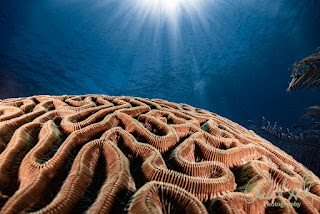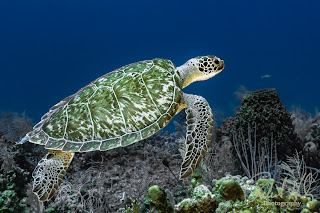How Post-Processing Tools Like Adobe Lightroom Are Outshining Expensive Cameras

The Evolution of Underwater Photography
Introduction
For years, the gold standard in underwater photography was
straightforward: the more advanced and expensive your camera, the better your
photos would be. This notion drove countless photographers to invest in
high-end gear, believing cutting-edge camera technology was the key to
capturing the vibrant, mysterious world beneath the waves. However, as time has
passed, a significant shift has occurred. Today, the focus has increasingly
moved away from expensive hardware to the powerful post-processing tools that
allow photographers to enhance and perfect their images in ways previously
unimaginable. In this blog, I'll dive into why this shift is happening and how
mastering tools like Adobe Lightroom can empower you to create stunning
underwater images without needing the latest camera technology.
Today when asked why my photographs look so good compared to those they take on the same dive, they assume and tell me that it must be my expensive camera. I explain that if I had it to do all over again today, I would buy a good, reasonably priced camera and setup and still be able to achieve the quality of pictures I take today. It is no longer about the size or price of an underwater rig, it is all about post-processing. I even offer to take one of their photos and transform it into the quality that my photograph shows, using post-processing tools like Adobe Lightroom.
Let's look at this shift from camera-centric photography to post-processing-centric underwater photography.
The Camera-Centric Era: When Gear Was King
In the early days of underwater photography, the primary
challenge was overcoming the unique difficulties posed by the underwater
environment. Limited light, color distortion, and the need for robust,
pressure-resistant housing meant that those with the most advanced equipment usually took the best pictures. High-end cameras with superior sensors,
optics, and controls were seen as essential for capturing the underwater world
with any degree of fidelity.
These cameras were designed to handle the technical
challenges of underwater photography, from dealing with low light to
maintaining sharpness and clarity at significant depths. As a result, the
prevailing wisdom was that the best photos could only be achieved by those who
invested in the best equipment.
The Rise of Post-Processing: Shifting the Focus
As digital photography evolved, so too did the tools
available for editing and enhancing images. Adobe Lightroom, in particular,
revolutionized the way photographers approached their work. No longer was the
camera solely responsible for the final image quality; Lightroom enabled
photographers to bring out the best in their shots, correcting imperfections,
enhancing colors, and adding artistic flair in ways that weren’t possible at
the time of capture.
This development marked a significant shift in underwater
photography. The emphasis moved from the camera’s abilities to the
photographer’s skills in post-processing. Today, a well-edited image taken with
a mid-range camera can rival or even surpass a photo taken with the most
expensive equipment. This shift has democratized underwater photography,
allowing more people to achieve professional-level results without needing to
spend a fortune on gear.
Why the Shift Is Happening
Several key factors have driven this transition from
hardware-dependent photography to a more software-focused approach:
- Advancements
in Camera Technology: While high-end cameras still offer significant
advantages, the gap between mid-range and top-tier models has narrowed.
Even affordable cameras now offer impressive image quality, making it
easier for photographers to capture good raw material to work with in
post-processing.
- Incredible Capabilities of Post-Processing Software: Modern editing tools, especially Adobe Lightroom, have become incredibly powerful. With features like precise color correction, exposure adjustments, and detail enhancement, photographers can elevate their images to new heights. These tools allow for corrections and enhancements that would be impossible to achieve solely through the camera’s capabilities.
- Learning Curve and Education: The learning curve for post-processing software has also become more manageable, with a wealth of tutorials, courses, and communities (like the one I've developed) offering guidance. This accessibility has empowered more photographers to improve their editing skills, making it a more viable path to stunning photography.
- Cost-Effectiveness: Investing in top-tier cameras and lenses can be prohibitively expensive. However, investing in a good camera paired with powerful post-processing software offers a more affordable path to high-quality images. This combination allows photographers to achieve professional results without needing to invest in the most expensive gear.
- Creative Control: Post-processing provides photographers with greater creative control over their images. They can experiment with different styles, correct mistakes, and enhance the mood of their photos in ways that simply weren't possible before.
Expanded Examples of the Shift
To illustrate how this shift is playing out in real-world
underwater photography, let’s delve deeper into some scenarios where
post-processing shines:
- Scenario
1: Deep Dives and Low Light Conditions
Imagine you're diving at a depth where natural light barely
penetrates. In the past, this would have required a camera with exceptional
low-light performance, often at a high price tag. Today, even with a mid-range
camera, you can capture a usable image by focusing on composition and exposure.
Once back on land, Lightroom allows you to bring out the details hidden in the
shadows, enhance the colors that are naturally muted at depth, and reduce noise
that often accompanies low-light photography. The final image can appear as if
it was taken in ideal conditions, highlighting the beauty of the underwater
world despite the challenging environment.
- Scenario
2: White Balance and Color Correction
Underwater, colors shift dramatically due to the way water
absorbs and scatters light. Even the best cameras struggle with white balance,
often resulting in images that are overwhelmingly blue or green. In the past,
correcting this required meticulous manual settings and often multiple
attempts. Today, Lightroom’s color correction tools can quickly and effectively
restore the natural colors of the scene. For example, a photo of a coral reef
that appears blue and dull straight out of the camera can be transformed with a
few adjustments, revealing the vibrant reds, oranges, and yellows of the coral.
The ability to correct white balance post-capture means you can focus on the
shot’s composition and lighting without worrying about getting the colors
perfect in the camera.
- Scenario
3: Enhancing Details and Sharpness
Suppose you’re shooting fast-moving marine life, like a
school of fish or a darting squid. Even with the best camera, capturing these
moments with perfect clarity can be challenging. Older or mid-range cameras
might leave the image slightly soft or lacking in detail. However, with
Lightroom, you can enhance the sharpness and clarity of your images, bringing
out the intricate details of the marine life. The sharpening and detail
enhancement tools allow you to recover the texture of a fish’s scales or the
delicate patterns on a squid’s body, turning a decent shot into an exceptional
one.
- Scenario
4: Creative Adjustments and Artistic Expression
Sometimes, the goal isn’t just to recreate the scene as it
appeared in reality but to convey a particular mood or artistic vision.
Post-processing tools like Lightroom provide endless possibilities for creative
adjustments. For example, you might want to emphasize the mystery of a sunken
ship by increasing contrast and deepening shadows, or you could enhance the
dreamlike quality of a jellyfish floating through the water by softening the
edges and boosting the highlights. These creative choices allow you to turn a
standard underwater photo into a unique piece of art that stands out.
Conclusion: Embracing the New Era of Underwater
Photography
The world of underwater photography has evolved, and with
it, the tools and techniques used to capture stunning images. While high-end
cameras still have their place, the ability to achieve remarkable results no
longer relies solely on having the most advanced gear. Today, it’s about the
marriage of good photography and expert post-processing.
This shift has made underwater photography more accessible
and rewarding to hobbyists and professionals than ever before. Whether you’re a seasoned pro or just starting
out, investing time in mastering tools like Adobe Lightroom can open up a world
of possibilities, allowing you to create breathtaking images that capture the
beauty and wonder of the underwater realm. So, the next time you dive into the
deep blue, remember that the true power of your photography lies not just in
the camera you hold but in the skills you bring to the editing table.
Stay Connected
Follow my blog for more tips and tutorials on underwater photography. Let's dive deeper into the art and craft of capturing the marine world!
Subscribe to my blog for more tips and tutorials on underwater photography. Don’t forget to share your processed photos on social media using the hashtag #RobertHerbPhotography. I look forward to reviewing your results.
New Online Training Program
I am excited to announce that I am creating an online training program to teach underwater hobbyists and enthusiasts how to enhance their photos using Adobe Lightroom. If you are interested in this training, please contact me at bob@robertherb.com to express your interest and to be notified about the details and start date of the classes.
Stay tuned and "Follow" for upcoming blogs on underwater photography tips and tricks for more in-depth insights. Please leave your comments and suggestions. Enjoy your diving and shooting experience!
I am eagerly anticipating your valuable feedback and suggestions.
Sincerely,
Bob Herb
|
|




Comments
Post a Comment
Please let me know your comments.